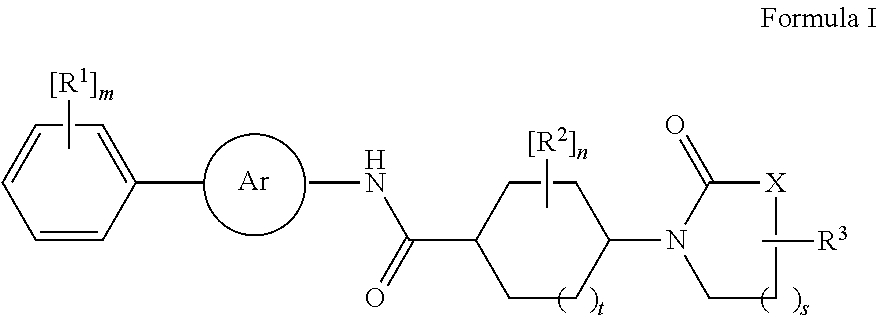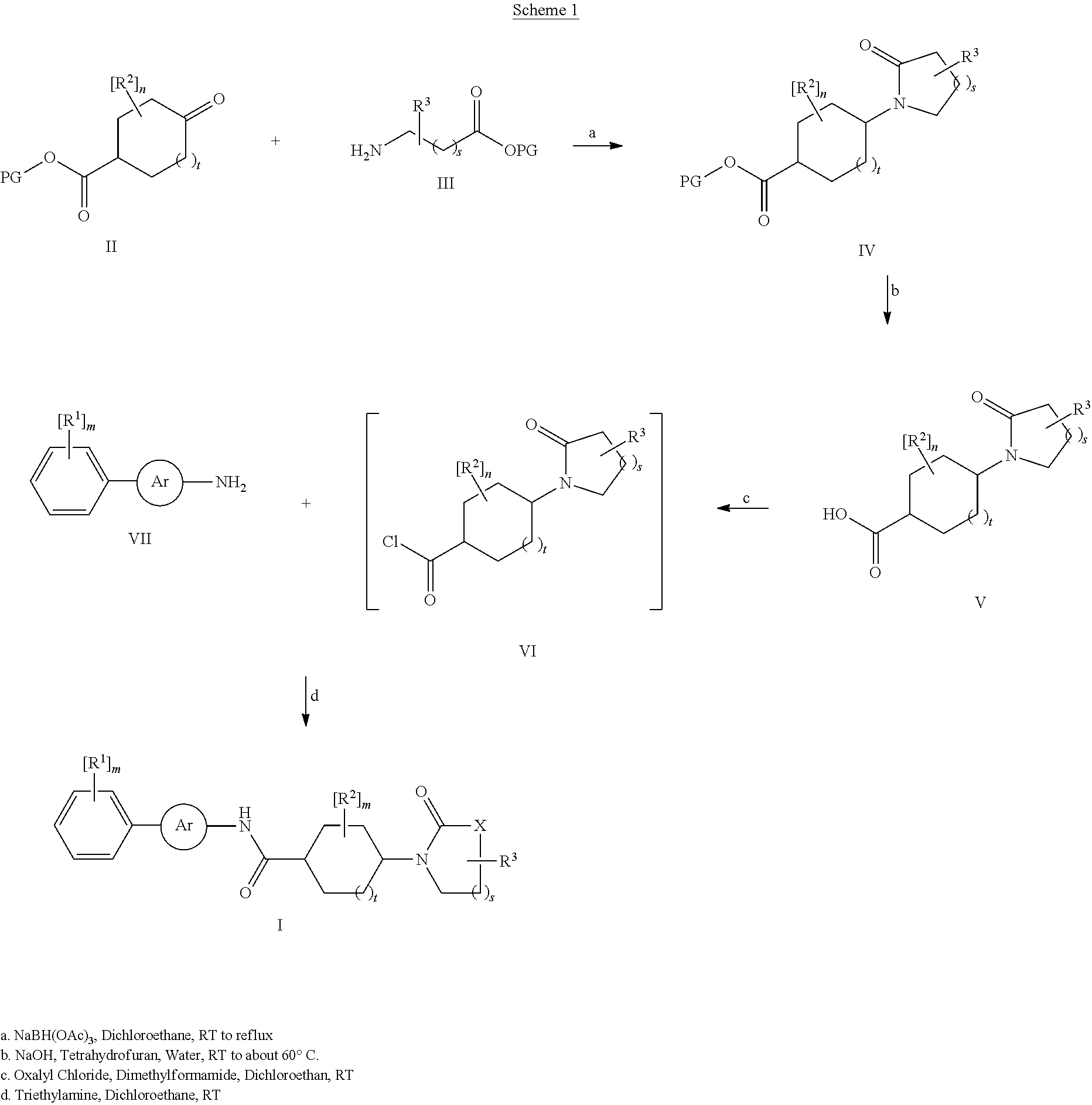Amide derivatives as neuropeptide y5 receptor ligands
a neuropeptide y5 receptor and derivative technology, applied in the field of compounds, can solve the problems of unsatisfactory treatment effect, undesired side effects, and many patients who do not fully respond to treatmen
- Summary
- Abstract
- Description
- Claims
- Application Information
AI Technical Summary
Benefits of technology
Problems solved by technology
Method used
Image
Examples
example 1a
trans-4-(2-Oxo-pyrrolidin-1-yl)-cyclohexanecarboxylic acid [5-(3,5-difluoro-phenyl)-pyridin-2-yl]-amide
[0104]
[0105]4-(2-Oxo-pyrrolidin-1-yl)-cyclohexanecarboxylic acid (211 mg, 1 mmole) was added to 1,2-dichloroethane (5 ml) with stirring. Oxalyl chloride (150 ul, 1.82 mmoles) followed by N,N-dimethylformamide (15 ul, 0.19 mmoles). The reaction mixture was stirred for 3 hours at room temperature. The resulting oxo-(pyrrolidin-1-yl)-cyclohexanecarbonyl chloride solution was used without further purification.
[0106]5-(3,5-Difluoro-phenyl)-pyridin-2-ylamine (103 mg, 0.50 mmoles) and triethylamine (140 uL, 1.00 mmoles) were dissolved in dichloromethane (10 ml). 4-(2-Oxo-pyrrolidin-1-yl)-cyclohexanecarbonyl chloride (115 mg, 0.50 mmoles) as a solution in dichloromethane (5 mls) was added and the reaction mixture was stirred overnight at 55° C. After cooling to room temperature the reaction mixture was diluted with 20 ml ethyl acetate, transferred to a separatory funnel, and washed with 10...
example 1b
cis-4-(2-Oxo-pyrrolidin-1-yl)-cyclohexanecarboxylic acid [5-(3,5-difluoro-phenyl)-pyridin-2-yl]-amide
[0108]
[0109]Prepared from cis-4-(2-oxo-pyrrolidin-1-yl)-cyclohexanecarboxylic acid and 5-(3,5-difluoro-phenyl)-pyridin-2-ylamine. 1H NMR (400 MHz, CDCl3) δ 8.48 (d, 1H), 8.35 (d, 1H), 8.19 (s, 1H), 7.91 (dd, 1H), 7.10 (d, 2H), 6.85 (tt, 1H), 4.07 (m, 1H), 3.38 (t, 2H), 2.73 (br s, 1H), 2.41 (t, 2H), 2.26 (d, 2H), 2.00 (m, 2H), 1.86 (m, 4H), 1.68 (d, 2H). ESI-MS m / z: 400 (M+H)+; tR=1.22 min (Method A). The cis stereochemistry was assigned based on the chemical shift (4.07 ppm) and splitting (m) of the methine proton at C-1 of the cyclohexane ring and on the chemical shift (2.73 ppm) and splitting (br s) of the methine proton at C-4 of the cyclohexane ring in the NMR spectrum.
example 1c
cis-4-(2-Oxo-pyrrolidin-1-yl)-cyclohexanecarboxylic acid [5-(3,5-dichloro-phenyl)-pyridin-2-yl]-amide
[0110]
[0111]Prepared from cis-4-(2-oxo-pyrrolidin-1-yl)-cyclohexanecarboxylic acid and 5-(3,5-dichloro-phenyl)-pyridin-2-ylamine. 1H NMR (400 MHz, CDCl3) δ 9.23 (s, 1 H), 8.40 (d, 2H), 7.9 (d, 1 H), 7.45-7.35 (3H), 4.04 (m, 1H), 3.38 (t, 2H), 2.74 (br s, 1H), 2.39 (t, 2H), 2.22 (d, 2H), 1.98 (m, 2H), 1.84 (m, 4H), 1.63 (d, 2H). ESI-MS m / z: 432 (M+H)+; tR=1.49 min (Method A).
[0112]The cis stereochemistry was assigned based on the chemical shift (4.04 ppm) and splitting (m) of the methine proton at C-1 of the cyclohexane ring and on the chemical shift (2.74 ppm) and splitting (br s) of the methine proton at C-4 of the cyclohexane ring in the NMR spectrum.
PUM
 Login to View More
Login to View More Abstract
Description
Claims
Application Information
 Login to View More
Login to View More - R&D
- Intellectual Property
- Life Sciences
- Materials
- Tech Scout
- Unparalleled Data Quality
- Higher Quality Content
- 60% Fewer Hallucinations
Browse by: Latest US Patents, China's latest patents, Technical Efficacy Thesaurus, Application Domain, Technology Topic, Popular Technical Reports.
© 2025 PatSnap. All rights reserved.Legal|Privacy policy|Modern Slavery Act Transparency Statement|Sitemap|About US| Contact US: help@patsnap.com



